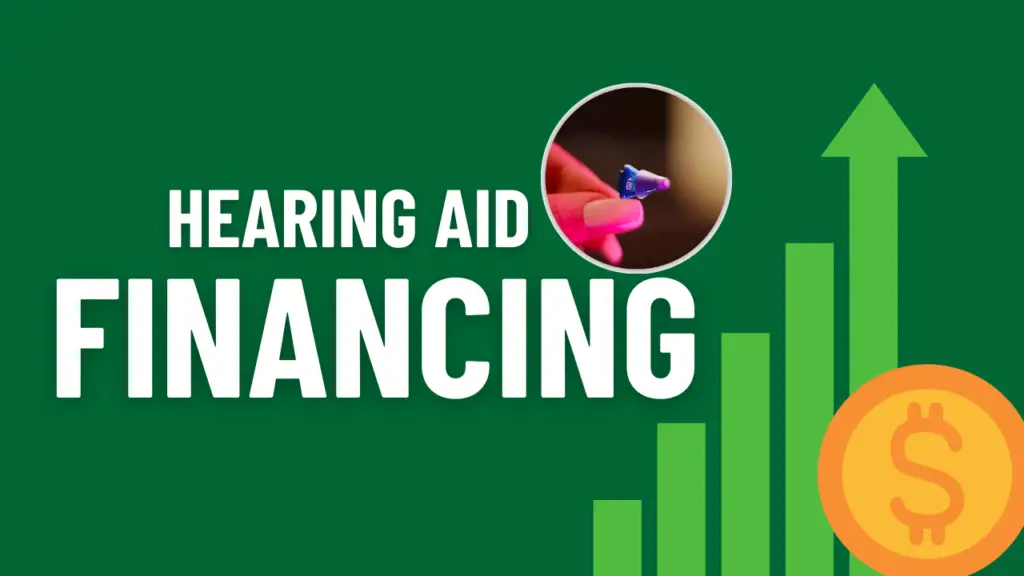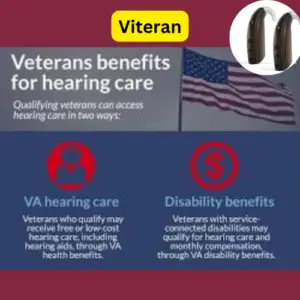Hearing Aid Financing is the solution for the people who is Struggling with hearing loss yet concerned about the expense of hearing aids? You are not alone. Hearing aids can be expensive, but there are several financing alternatives available to help you acquire the hearing assistance you want. This thorough guide looks at all of your choices, including insurance coverage, patient assistance programs, and finance methods. You’ll also learn about the many varieties of hearing aids and their pricing, allowing you to make an informed decision about the best option for your budget and hearing requirements.

Introduction:
Hearing loss is a common and sometimes underappreciated health condition that affects millions of people throughout the world. It not only impairs one’s capacity to communicate but can also lead to social isolation and a lower quality of life. While hearing aids are revolutionary technologies that can help with these issues, the expense of purchasing them remains a substantial barrier for many people. In this in-depth examination, we will dig into the difficulties of hearing aid financing, ensuring that thorough information is presented to assist individuals on their journey to improved hearing.
Understanding the Cost:
The price of hearing aids varies greatly depending on multiple factors, including brand, model, features, and supplier. A pair of hearing aids can cost anything from a few hundred to several thousands of dollars. The cost variation might be due to technological developments like as digital signal processing and noise reduction technologies, which improve the devices’ overall performance.
Basic Models vs. Advanced Technology:
Hearing the world again shouldn’t break the bank! For many hearing aid users, affordability is a major concern. While advanced technology models offer incredible features, basic models can effectively improve your hearing in quieter environments.
The good news: Financing options are available to help make hearing aids accessible. Explore insurance coverage, patient assistance programs, and flexible payment plans to find a solution that fits your budget. Remember, investing in your hearing is an investment in your overall well-being and quality of life.
Brands and Providers:
Brand Recognition and Technology:
- Established brands: Often invest heavily in research and development, leading to more advanced features and capabilities. These features, like Bluetooth connectivity, noise cancellation, and directional microphones, naturally come at a premium.
- Lesser-known brands: May offer more basic models at lower prices, focusing on essential amplification without bells and whistles. These can be ideal for individuals with mild hearing loss or those prioritizing affordability.
Audiologist and Hearing Care Professional Fees:

- Experience and expertise: More experienced professionals may charge more for their personalized consultations and fine-tuning of your hearing aids.
- Location and overhead costs: Hearing care practices in areas with higher living costs might have higher fees to cover their expenses.
- Services offered: Some practices offer bundled packages that include follow-up appointments, cleanings, and adjustments, while others charge separately for these services.
Additional factors to consider:
- Warranty and return policies: More expensive models often come with longer warranties and more flexible return policies, offering peace of mind.
- Customization options: Some brands offer a wider range of customization options, such as different styles and colors, which can affect the price.
Remember:
Consult with multiple audiologists: Compare their fees and services to find the best fit for your budget and needs.
Ask about financing options: Many manufacturers and hearing care professionals offer financing plans to make hearing aids more accessible.
Focus on value, not just price: Consider the features, benefits, and long-term value you’ll receive when making your decision.
Insurance Coverage: On hearing aid financing option
Understanding your health insurance coverage is crucial when considering hearing aid financing. Unfortunately, not all insurance plans cover hearing aids, and coverage can vary widely. Here are some considerations:
Navigating private health insurance for hearing aids can be confusing, but this guide can help you maximize your coverage:
Reviewing Your Existing Policy:
- Start by carefully reviewing your current plan documents. Look for specific details about hearing aid coverage, including:
- Percentage of cost covered: Some plans cover a fixed percentage (e.g., 50%), while others reimburse up to a specific dollar amount.
- Annual limits: Many plans have yearly caps on hearing aid coverage.
- Covered brands/models: Some plans might only cover specific brands or models, limiting your options.
- Exclusions: Be aware of any exclusions, such as cosmetic features or repairs.
- Utilize online resources. Many insurance companies provide online tools to search and understand your specific plan coverage. Government agencies like Medicare also offer resources to navigate insurance benefits.
Adding Hearing Aid Benefits:
- Consider adding a hearing aid benefit rider to your existing plan. This might increase your premium, but it could significantly reduce out-of-pocket expenses.
- Check your eligibility. Some riders have age restrictions or require pre-approval based on hearing test results.
- Compare the cost-benefit. Calculate the additional premium cost and compare it to the potential decrease in out-of-pocket expenses to assess if it’s financially worthwhile.
Exploring Alternative Insurance Plans:
- Research alternative plans specializing in hearing health. These plans often offer more comprehensive coverage for hearing evaluations, fittings, and devices.
- Types of plans: Explore options like Medicare Advantage plans with additional hearing benefits or specialized hearing insurance offered by independent companies.
- Comparison resources: Utilize online tools or platforms designed to compare benefits and costs across different insurance options.
Additional Tips:
- Consult a hearing professional for proper diagnosis and guidance. They can recommend suitable hearing aids even with insurance limitations.
- Advocate for yourself. Contact your insurance provider or elected officials to express the need for better hearing aid coverage within healthcare plans.
Remember:
-
- Hearing aid coverage varies significantly across different plans and companies.
- Carefully compare options and choose the one that best meets your needs and budget.
- Consulting a hearing professional and advocating for better insurance coverage are crucial steps in ensuring affordable access to hearing solutions.
Hearing Aid Financing Options: A Comparison Table with Resources
| Option | Description | Pros | Cons |
|---|---|---|---|
| CareCredit | Widely accepted healthcare credit card | Flexible payment plans, low/zero interest options sometimes available | Requires good credit score, annual fees apply |
| In-House Financing | Offered by some hearing care providers | Convenient, tailored terms, potential for lower interest rates | Limited availability, terms depend on individual provider |
| Third-Party Financing Companies | Partner with hearing professionals | Competitive rates, extended payment plans | Credit score requirements vary, potential hidden fees |
| Nonprofit Assistance | Grants, loans from dedicated organizations | Reduced financial burden, often needs-based | Limited availability, income restrictions may apply |
| Manufacturer Financing | Offered by some hearing aid brands | Direct payments to manufacturer, convenient | Credit score requirements may vary, limited brand selection |
Medicare and Medicaid:
While Medicare, the federal health insurance program for individuals aged 65 and older, generally does not cover the cost of hearing aids, Medicaid, the joint federal and state program for low-income individuals, may offer assistance. Consider the following:
Navigating Medicaid coverage for hearing aids requires understanding variations across states. Here’s a breakdown:
State-by-State Variations:
- Coverage specifics: Each state establishes its own Medicaid program, leading to significant differences in hearing aid coverage.
- Comprehensive vs. limited: Some states offer full or partial coverage for adult beneficiaries, while others only cover children or have specific eligibility requirements.
- Covered devices: Coverage might extend to basic models, exclude advanced features, or limit the number of hearing aids per recipient.
Finding Your State’s Coverage:
- Medicaid.gov: Visit the official Medicaid website and use the state selector to access your state’s program details.
- State Medicaid agency websites: Each state’s Medicaid agency website provides specific information on hearing aid coverage and eligibility criteria.
- National Hearing Loss Association (NHLA): Utilize the NHLA’s state-by-state resources for comprehensive information and advocacy support.
Dual Eligibility (Medicare and Medicaid):
- Individuals qualifying for both programs may benefit from broader coverage. Medicare generally doesn’t cover hearing aids, but dual eligibility can unlock supplemental Medicaid benefits.
- Explore your state’s specific Medicaid coverage for dual beneficiaries. This could include wider device choices, more frequent replacements, or additional services like hearing evaluations and therapy.
Additional Considerations:
- Income eligibility: Medicaid is a need-based program, so income thresholds vary by state and affect program eligibility.
- Prior authorization: Depending on your state’s program, prior authorization from a healthcare professional might be needed before your hearing aid costs are covered.
- Appeals process: If your request for coverage is denied, understand and utilize the appeals process outlined by your state’s Medicaid program.
Remember:
-
- Medicaid hearing aid coverage varies across states, so research your specific program details.
- Utilize available resources like state websites and the NHLA for comprehensive information and support.
- Consider dual eligibility benefits if you qualify for both Medicare and Medicaid.
- Stay informed about your state’s program updates and changes in coverage policies.
Veterans Affairs (VA) Benefits:
Veterans are entitled to hearing healthcare services through the Department of Veterans Affairs (VA). This comprehensive program covers a range of services, including evaluations, fittings, and hearing aids:
Veterans who experience hearing loss have access to valuable hearing healthcare services and hearing aids through the Department of Veterans Affairs (VA). Here’s a breakdown of eligibility, enrollment, and VA Hearing Aid Centers:
Eligibility:
- Military service: You must have served in the active military, Army National Guard, or Air National Guard.
- Discharge status: Your discharge must be other than dishonorable.
- Income: While income doesn’t automatically disqualify you, it may affect your copay amount.
Enrollment:
- Register with the VA: Visit the VA website and create an account or contact your nearest VA Medical Center.
- Apply for healthcare: Complete VA Form 10-10EZ Application for Health Care Benefits.
- Schedule an appointment: Once enrolled, schedule an appointment with an audiologist at your local VA Medical Center.
VA Hearing Aid Centers:
-
- Dedicated care: Many VA Medical Centers have specialized Audiology Departments staffed by experienced audiologists.
- Comprehensive services: These departments offer various services, including hearing evaluations, hearing aid fittings, programming, and ongoing support.
- Hearing aid provision: Eligible veterans receive hearing aids at no cost, with options ranging from basic models to advanced features.
Additional Resources:
Remember:
-
- Eligibility requirements may vary slightly depending on your specific circumstances.
- Contact your local VA Medical Center for personalized guidance and assistance.
- The VA is committed to providing comprehensive hearing healthcare services to veterans, ensuring access to the hearing solutions they need.
Hearing Aid Financing Programs:
Recognizing the financial challenges associated with hearing aid acquisition, various financing programs have been developed to facilitate access to this life-changing technology:
Financing Your Hearing Journey: Exploring Different Options
The cost of hearing aids can be a barrier for many individuals who need them. However, several financing options are available to help make hearing health more accessible. Here’s a breakdown of some popular methods:
CareCredit:
- A widely accepted healthcare credit card used by various audiologists.
- Offers flexible payment plans with varying lengths and sometimes low or zero interest rates.
In-House Financing:
- Many hearing care providers offer their own financing options with tailored terms and interest rates.
- Convenient way to directly manage payments with your clinic.
Third-Party Financing Companies:

- Hearing professionals often partner with specialized healthcare financing companies.
- May provide competitive interest rates and extended payment plans.
Nonprofit Organizations:

- Several nonprofits and charities support individuals with hearing loss.
- They may offer financial assistance, grants, or low-interest loans for hearing aids.
Manufacturer Financing:
- Some hearing aid manufacturers directly offer financing options through partnerships.
- This allows for affordable payments directly to the manufacturer over time.
Additional factors to consider:
-
- Interest rates and fees: Compare interest rates, annual fees, and other charges associated with each option.
- Credit score requirements: Certain financing options may have minimum credit score requirements.
- Repayment terms: Choose a plan with comfortable monthly payments that fit your budget.
- Hidden costs: Be aware of any potential processing fees or add
Conclusion:
To summarize, hearing aid funding is a challenging environment with several choices accessible to those seeking assistance. Understanding the expenses of hearing aids, looking into insurance coverage, and researching government programs like Medicare, Medicaid, and VA benefits are all important steps on the path to improved hearing.
Furthermore, hearing aid financing schemes such as CareCredit, in-house financing, third-party financing, nonprofit help, and manufacturer financing offer a range of solutions to suit a variety of financial conditions. Nobody should be denied the opportunity to explore the world of sound because of budgetary restraints.
As technology evolves and awareness of hearing health increases, it is critical to remain current on the changing environment of hearing aid funding.
FAQs for Hearing Aid Financing:
1. How much do hearing aids cost?
Hearing aid prices vary widely depending on the technology, features, and brand. Basic models can start around $1,000 each, while advanced models with Bluetooth and noise cancellation can cost several thousand dollars per pair.
2. What financing options are available for hearing aids?
Several options exist, including:
- Private health insurance: Some plans offer partial coverage, but many don’t cover hearing aids at all.
- Medicaid: Coverage varies by state, but some states offer comprehensive coverage for adults and children.
- Veterans benefits: Veterans qualify for hearing aid services and devices through the VA healthcare system.
- CareCredit: A healthcare credit card with flexible payment plans and sometimes low or zero interest rates.
- In-house financing: Some hearing care providers offer their own financing options with tailored terms.
- Third-party financing companies: Partner with hearing professionals and may offer competitive rates and extended plans.
- Nonprofit assistance: Grants and low-interest loans from dedicated organizations.
- Manufacturer financing: Direct financing options from some hearing aid brands.
3. What is the best financing option for me?
The best option depends on your individual circumstances, including your credit score, budget, and insurance coverage. Compare interest rates, fees, and repayment terms before making a decision. Consult with your hearing professional and, if needed, a financial advisor for personalized guidance.
4. Can I afford hearing aids without insurance?
Yes, even if you don’t have insurance, various financing options can make hearing aids more accessible. Explore financing options listed above, consider basic models, and seek assistance from non-profit organizations if needed.
5. Where can I learn more about hearing aid financing?
Several resources can help you explore your options:
- Hearing Loss Association of America (HLAA)
- American Speech-Language-Hearing Association (ASHA)
- National Institute on Deafness and Other Communication Disorders (NIDCD)
- Hearing healthcare professionals: Consult with your audiologist for personalized advice and information on available financing options in your area.





1 thought on “Hearing Aid Financing: A Comprehensive Guide”